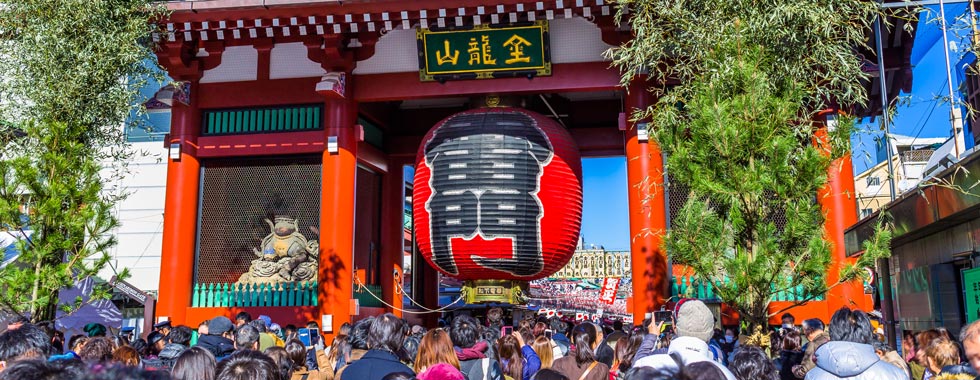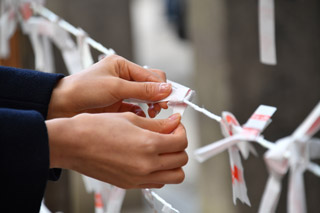
2022.01.20
Wherever you go in Japan, you can almost always find a shrine or temple nearby. Despite this, Japanese people are fairly casual about religion and tend to practice a mix of Buddhism and Shintoism. There is one religious tradition that almost everyone in the country participates in however - "hatsumode". Hatsumode refers to the first visit to a shrine or temple of the year which people visit to cleanse themselves and pray for the year to come. Many people head to their local shrine or temple in the dark of the night in order to be there for when the clock strikes midnight. Unlike in Western countries, midnight on New Year's in Japan is a quiet and solemn occasion, where one should reflect on the year that has just passed and the year to come. If you don’t want to venture out into the cold night, you can still participate in hatsumode over the first few days of the New Year.
SEEK YOUR FORTUNE FOR THE UPCOMING YEAR

Most temples and shrines offer "omikuji", or fortune papers. People buy one for about 100 yen and choose their fortune. The paper contains the level of luck you will experience in the upcoming year (such as "medium luck"), as well as more specific information in various areas like finance, romance and health. If you draw a good fortune, keep it. If you get a bad fortune, tie it up in a certain spot at the temple or shrine in order to pray for better luck.
WHICH SHOULD YOU VISIT: A SHRINE OR A TEMPLE?
For Hatsumode, either a shrine or a temple may be visited. There are a few key differences between the two which you might want to be aware of.
●Shrines:
Shrines are Shinto and usually feature red torii gates which are said to act as a gateway between this world and that of the gods. Shintoism originated in Japan with followers believing that thousands of Gods can be found in nature - in the rivers, mountains, rocks and trees. Fundamentally Shinto offers a great respect for nature.
●Temples:
Temples are Buddhist and feature many Buddhist statues, burning incense and potentially a graveyard attached. Buddhism originally came to Japan from India and China, and is still casually practised by about two thirds of the population today.
Although throughout history the two philosophies have been in conflict, Buddhism and Shintoism now peacefully co-exist in Japan. Weddi
RECOMMENDED SHRINES AND TEMPLES AT WHICH TO DO HATSUMODE

Nezu Shrine
Nezu is one of Tokyo's oldest Shrines, dating back to the early 1700s. It is most famous for its azalea festival in April, when thousands of azalea flowers bloom along the hilly banks of this shrine. It has a fairly sizable row of vermilion torii gates resembling Kyoto's Fushimi Inari Shrine, which make for a great photo. The colourful architecture of Nezu justifies its designation as an Important Cultural Heritage site and elevates it beyond "just another shrine". Large grounds and a quiet neighbourhood make Nezu an ideal location for Hatsumode as it is not too crowded while still being a very impressive destination.

Nezu is part of the traditional “Yanesen” area comprising of Yanaka, Nezu and Sendagi. After visiting the shrine, you can take a stroll to other places of interest in the area such as Yanaka Cemetery, Yanaka Ginza and the historic Yanaka Beer Hall, a hundred year old restored house now brewing local beer and located next to an amazing hidden bakery.
Access: 5 minutes walk from Nezu Station on the Tokyo Metro Chiyoda Line.

Kameido Shrine
Built in 1661 Kameido Tenjin Shrine is located in the nostalgic area of Tokyo known as "Shitamachi", or the old working class area filled with history and nostalgia. Kameido Shrine is dedicated to Michizane no Sugawara, the God of Study and Learning. Due to this, it is a popular spot for students to come to pray for good results in their exams. While Kameido is most popular in Spring for its wisteria displays, it is a very picturesque shrine with Tokyo SkyTree in the backdrop meaning that it is fairly lively on New Year’s Day.
From the shrine, you could choose to walk to Kinshicho Station, which is a shopping hub, or you could follow the Kitajukken River path to Tokyo SkyTree. Wanpaku Tengoku is a nice park with woodworking for kids along the way. Alternatively, walk toward the Arakawa River and head to Ojima-Komatsugawa Park, a large park with a good playground and lots of green space.
Access: 15 minutes walk from Kameido station on the JR Sobu Local line.

Shinagawa Shrine
These days Shinagawa is a major transportation hub, but it still maintains sections of old town, along with 17 shrines and temples. The most popular of these for Hatsumode is Shinagawa Shrine. Shinagawa Shrine is said to be where one can pray for both money, health and luck, so many people flock here to pray for a prosperous coming year. The shrine is actually one of ten shrines which form a ring around the Imperial Palace, which were appointed by the Meiji Emperor as symbols of the new era. The shrine also features a mini Mt. Fuji hill, which was built long ago for those unable to make the pilgrimage to the actual Mt. Fuji. Shinagawa Shrine is actually famous worldwide – see if you can spot its brief appearance in the Shin Godzilla movie!
In the surrounding area is the Kita-Shinagawa area, which used to be a thriving checkpoint station along the Old Tokaido Road, ancient road that connected Tokyo with Kyoto. Weary travellers would stop there for rest, replenishment and entertainment. You can still see many original buildings and shops which date back hundreds of years. Check the old Ura Funadamari port and then walk down the Kyu-Tokaido Road.
Access: 2 minutes walk from Shinbaba Station on the Keikyu Line.

Sensoji Temple
Founded in the year 645, Sensoji Temple in Asakusa is Japan’s oldest temple and a popular destination for New Year's worshippers. Its guardian deity is said to bring you luck in the finance and career aspects of your life, so this temple attracts many hoping to increase their fortune. Stalls line Nakamise Shopping Street leading up to Sensoji and peddlers will be selling their wares if you go in daytime. The atmosphere is lively and festive rather than quiet and contemplative, so choose this Temple if that appeals to you.

There is a lot to do in the surrounding area after you have been to Sensoji. You could take a walk across the Sumida River to the Sumida Park which has a nice grass area suitable for a picnic. From there, it’s a short walk to Tokyo SkyTree which has plenty of shopping options along with a kid’s indoor play centre and an aquarium. Tucked away behind Sensoji is Hanayashiki, Japan's oldest amusement park, around since 1853. If you head to the river and fancy seeing SkyTree from a different angle, the Suijo Bus is a nice water cruise option which you can take all the way to Odaiba.
Access: 2 minutes walk from Asakusa Station on the Ginza and Asakusa Lines or Tobu-Asakusa Station on the Tobu Line.

Shibamata Taishakuten
Shibamata Taishakuten is quite off-the-beaten-track, located in Katsushika-ku, part of "old Tokyo". This temple was spared during World War II and thus offers a rare sight into a part of Tokyo preserved from before the war. The temple is dedicated to the Buddhist figure Taishakuten and contains many interesting wooden sculptures carved by the same artist who contributed to the Nikko Toshogu Shrine. The road leading up to the temple is full of quaint old shops from which you can buy a snack to welcome in the New Year.
One good thing about visiting Shibamata Taishakuten is that it is located in the neighbourhood of Shibamata, which offers a lot more than just this shrine. Walk the long shopping street and stop to buy old fashioned sweets and toys. Head to the Yamamoto-tei, an old merchant house which is now open to the general public and has a lovely Japanese garden out the back. Fans of the anime "Otoko wa Tsurai yo" may appreciate the Tora-san Museum and everyone will delight in the Yagiri no Watashi, Tokyo's only traditional river boat crossing remaining. There isn't much to do on the other side of the river so you will want to opt for the return trip, which is just for fun and nostalgia.
For something New Year's related, Shibamata is also home to an excellent "shichifukujin" (Seven Gods of Fortune) walk, which takes you around to seven different shrines where you collect the stamp of a different god of fortune until you have found the set. These walks are found all over Tokyo, but the Shibamata walk is very quiet and peaceful and allows you to explore this hidden section of "old Tokyo", stopping also at Shinsho-in Temple, Ryokan-ji Temple, Kanzo-ji Temple, Iou-ji Temple, Hosho-in Temple and Manpuku-ji Temple.
Access: 5 minutes walk from Shibamata Station on the Keisei Line
Article courtesy : OMAKASE Tour https://omakase-tour.com/